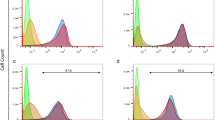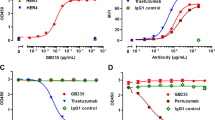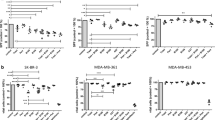Abstract
Dual therapy targeting human epidermal growth factor receptor 2 (HER2) by pertuzumab and trastuzumab (Herceptin) resulted in the significant survival of patients with HER2-positive breast cancers. However, a number of HER2-overexpressing breast cancers escape from this combination therapy. Due to several advantages of human single-chain antibodies (single chain variable fragments (scFvs)), these molecules were approved as valuable alternatives to entire IgGs for molecular targeting. In this study, our aim was to evaluate the growth inhibitory effects of three novel human anti-HER2 scFvs on breast cancer cells either alone or in combination and to assess their influence on HER2 expression in these cells. Flow cytometry was performed to show the cell binding ability of the scFvs to HER2-overexpressing cell lines, BT-474 and SKBR-3 cells, and HER2 low-expressing cell line, HeLa cells. The antiproliferative effects of the antibodies on the cancer cells were assessed by MTT assay. The amounts of HER2 gene and protein expression after antibody treatments were determined by quantitative real-time PCR and western blotting, respectively. FACS analysis showed that the anti-HER2 scFvs bound to BT-474 and SKBR-3 cells significantly higher than HeLa cells. Growth inhibitory assessment demonstrated that the triple blockade of HER2 by a cocktail of the three anti-HER2 scFvs significantly inhibited the proliferation of the both cancer cells to a greater extent than scFvs individually, in dual combination (scFv-I and scFv-III), and Herceptin. The percentages of growth inhibition of BT-474 and SKBR-3 cells after treatment with the cocktail were up to 77.4 and 76.5 %, respectively. The three scFv antibodies also reduced HER2 expression at both the gene and protein levels individually and in combination. Our results suggest that the cocktail of the three anti-HER2 scFv-I, scFv-II, and scFv-III, which induces high growth inhibition in breast cancer cells and downregulates HER2 gene and protein expression, can be considered as a new alternative for targeting of HER2-positive breast cancers.




Similar content being viewed by others
References
Ravdin PM, Chamness GC. The c-erbB-2 proto-oncogene as a prognostic and predictive marker in breast cancer: a paradigm for the development of other macromolecular markers. Gene. 1995;159(1):19–27.
Slamon DJ, Clark GM, Wong SG, Levin WJ, Ullrich A, McGuire WL. Human breast cancer: correlation of relapse and survival with amplification of the HER-2/neu oncogene. Science. 1987;235(4785):177–82.
Yarden Y, Sliwkowski MX. Untangling the ErbB signalling network. Nat Rev Mol Cell Biol. 2001;2(2):127–37.
Zaczek A, Brandt B, Bielawski KP. The diverse signaling network of EGFR, HER2, HER3 and HER4 tyrosine kinase receptors and the consequences for therapeutic approaches. Histol Histopathol. 2005;20(3):1005–15.
Garrett JT, Arteaga CL. Resistance to HER2-directed antibodies and tyrosine kinase inhibitors: mechanisms and clinical implications. Cancer Biol Ther. 2011;11(9):793–800.
Ghosh R, Narasanna A, Wang SE, Liu S, Chakrabarty A, Balko JM, et al. Trastuzumab has preferential activity against breast cancers driven by HER2 homodimers. Cancer Res. 2011;71(5):1871–82.
Scaltriti M, Verma C, Guzman M, Jimenez J, Parra JL, Pedersen K, et al. Lapatinib, a HER2 tyrosine kinase inhibitor, induces stabilization and accumulation of HER2 and potentiates trastuzumab-dependent cell cytotoxicity. Oncogene. 2009;28(6):803–14.
Wainberg ZA, Anghel A, Desai AJ, Ayala R, Luo T, Safran B, et al. Lapatinib, a dual EGFR and HER2 kinase inhibitor, selectively inhibits HER2-amplified human gastric cancer cells and is synergistic with trastuzumab in vitro and in vivo. Clin Cancer Res. 2010;16(5):1509–15.
Guan H, Jia SF, Zhou Z, Stewart J, Kleinerman ES. Herceptin down-regulates HER-2/neu and vascular endothelial growth factor expression and enhances taxol-induced cytotoxicity of human Ewing's sarcoma cells in vitro and in vivo. Clin Cancer Res. 2005;11(5):2008–17.
Hudis CA. Trastuzumab—mechanism of action and use in clinical practice. N Engl J Med. 2007;357(1):39–51.
Junttila TT, Akita RW, Parsons K, Fields C, Lewis Phillips GD, Friedman LS, et al. Ligand-independent HER2/HER3/PI3K complex is disrupted by trastuzumab and is effectively inhibited by the PI3K inhibitor GDC-0941. Cancer Cell. 2009;15(5):429–40.
Cobleigh MA, Vogel CL, Tripathy D, Robert NJ, Scholl S, Fehrenbacher L, et al. Multinational study of the efficacy and safety of humanized anti-HER2 monoclonal antibody in women who have HER2-overexpressing metastatic breast cancer that has progressed after chemotherapy for metastatic disease. J Clin Oncol. 1999;17(9):2639–48.
Nahta R, Esteva FJ. HER2 therapy: molecular mechanisms of trastuzumab resistance. Breast Cancer Res. 2006;8:215.
Vogel CL, Cobleigh MA, Tripathy D, Gutheil JC, Harris LN, Fehrenbacher L, et al. Efficacy and safety of trastuzumab as a single agent in first-line treatment of HER2-overexpressing metastatic breast cancer. J Clin Oncol. 2002;20(3):719–26.
Nagy P, Friedlander E, Tanner M, Kapanen AI, Carraway KL, Isola J, et al. Decreased accessibility and lack of activation of ErbB2 in JIMT-1, a herceptin-resistant, MUC4-expressing breast cancer cell line. Cancer Res. 2005;65(2):473–82.
Vu T, Claret FX. Trastuzumab: updated mechanisms of action and resistance in breast cancer. Front Oncol. 2012;2:62.
Sheridan C. FDA approves pertuzumab. Nat Biotechnol. 2012;30(7):570.
Capelan M, Pugliano L, De Azambuja E, Bozovic I, Saini KS, Sotiriou C, et al. Pertuzumab: new hope for patients with HER2-positive breast cancer. Ann Oncol. 2013;24(2):273–82.
Fedele C, Riccio G, Coppola C, Barbieri A, Monti MG, Arra C, et al. Comparison of preclinical cardiotoxic effects of different ErbB2 inhibitors. Breast Cancer Res Treat. 2012;133(2):511–21.
Drucker AM, Wu S, Dang CT, Lacouture ME. Risk of rash with the anti-HER2 dimerization antibody pertuzumab: a meta-analysis. Breast Cancer Res Treat. 2012;135(2):347–54.
Ahmad ZA, Yeap SK, Ali AM, Ho WY, Alitheen NB, Hamid M. scFv antibody: principles and clinical application. Clin Dev Immunol. 2012;2012:980250.
Liu F, Lu Q, Ye X, Fang C, Zhao Y, Liang M, et al. Cancer gene therapy of adenovirus-mediated anti-4–1BB scFv in immunocompetent mice. Cancer Biol Ther. 2008;7(3):448–53.
Monnier PP, Vigouroux RJ, Tassew NG. In vivo applications of single chain Fv (variable domain) (scFv) fragments. Antibodies. 2013;2:193–208.
Whitlow M, Bell BA, Feng SL, Filpula D, Hardman KD, Hubert SL, et al. An improved linker for single-chain Fv with reduced aggregation and enhanced proteolytic stability. Protein Eng. 1993;6(8):989–95.
Accardi L, Di Bonito P. Antibodies in single-chain format against tumour-associated antigens: present and future applications. Curr Med Chem. 2010;17(17):1730–55.
Dantas-Barbosa C, de Macedo BM, Maranhao AQ. Antibody phage display libraries: contributions to oncology. Int J Mol Sci. 2012;13(5):5420–40.
Zhao A, Nunez-Cruz S, Li C, Coukos G, Siegel DL, Scholler N. Rapid isolation of high-affinity human antibodies against the tumor vascular marker Endosialin/TEM1, using a paired yeast-display/secretory scFv library platform. J Immunol Methods. 2011;363(2):221–3.
Nejatollahi F, Asgharpour M, Jaberipour M. Down-regulation of vascular endothelial growth factor expression by anti-Her2/neu single chain antibodies. Med Oncol. 2012;29:378–83.
Cohen S. Cancer: past, present, and future. eBookIt.com (2013). http://www.barnesandnoble.com/w/cancer-sheldon-cohen-md-facp/1116226154?ean=2940148464273.
Hicks DG, Kulkarni S. HER2+ breast cancer: review of biologic relevance and optimal use of diagnostic tools. Am J Clin Pathol. 2008;129(2):263–73.
Awada A, Bozovic-Spasojevic I, Chow L. New therapies in HER2-positive breast cancer: a major step towards a cure of the disease? Cancer Treat Rev. 2012;38(5):494–504.
Wong ALA, Lee SC. Mechanisms of resistance to trastuzumab and novel therapeutic strategies in HER2-positive breast cancer. Int J Breast Cancer. 2012;2012:415170.
Swain SM, Kim SB, Cortés J, Ro J, Semiglazov V, Campone M, et al. Pertuzumab, trastuzumab, and docetaxel for HER2-positive metastatic breast cancer (CLEOPATRA study): overall survival results from a randomised, double-blind, placebo-controlled, phase 3 study. Lancet Oncol. 2013;14(6):461–71.
Cardinale D, Colombo A, Torrisi R, Sandri MT, Civelli M, Salvatici M, et al. Trastuzumab-induced cardiotoxicity: clinical and prognostic implications of troponin I evaluation. J Clin Oncol. 2010;28(25):3910–6.
Widakowich C, de Castro JG, de Azambuja E, Dinh P, Awada A. Side effects of approved molecular targeted therapies in solid cancers. Oncologist. 2007;12(12):1443–55.
Ren XR, Wei J, Lei G, Wang J, Lu J, Xia W, et al. Polyclonal HER2-specific antibodies induced by vaccination mediate receptor internalization and degradation in tumor cells. Breast Cancer Res. 2012;14(3):R89.
Liu D, Wang C, Li C, Zhang X, Zahng B, Mi Z, et al. Production and Characterization of a humanized single-chain antibody against human integrin αvβ3 protein. J Biol Chem. 2011;286:24500–7.
Montgomery RB, Makary E, Schiffman K, Goodell V, Disis ML. Endogenous anti-HER2 antibodies block HER2 phosphorylation and signaling through extracellular signal-regulated kinase. Cancer Res. 2005;65(2):650–6.
Wang JN, Feng JN, Yu M, Xu M, Shi M, Zhou T, et al. Structural analysis of the epitopes on erbB2 interacted with inhibitory or non-inhibitory monoclonal antibodies. Mol Immunol. 2004;40(13):963–9.
Kennel SJ. Effects of target antigen competition on distribution of monoclonal antibody to solid tumors. Cancer Res. 1992;52:1284–90.
Banappagari S, Ronald S, Satyanarayanajois SD. Structure-activity relationship of conformationally constrained peptidomimetics for antiproliferative activity in HER2-overexpressing breast cancer cell lines. Medchemcomm. 2011;2(8):752–9.
Nahta R. Molecular mechanisms of trastuzumab-based treatment in HER2-overexpressing breast cancer. ISRN Oncol. 2012;2012:428062.
Ceran C, Cokol M, Cingoz S, Tasan I, Ozturk M, Yagci T. Novel anti-HER2 monoclonal antibodies: synergy and antagonism with tumor necrosis factor-α. BMC Cancer. 2012;12:45.
Abraham J. Pertuzumab plus trastuzumab and docetaxel in HER2-positive metastatic breast cancer. Commun Oncol. 2012;9:42–4.
Tai W, Mahato R, Cheng K. The role of HER2 in cancer therapy and targeted drug delivery. J Control Release. 2010;146(3):264–75.
Harbeck N, Beckmann MW, Rody A, Schneeweiss A, Müller V, Fehm T, et al. HER2 dimerization inhibitor pertuzumab-mode of action and clinical data in breast cancer. Breast Cancer. 2013;8(1):49–55.
Garrett JT, Sutton CR, Kuba MG, Cook RS, Arteaga CL. Dual blockade of HER2 in HER2-overexpressing tumor cells does not completely eliminate HER3 function. Clin Cancer Res. 2013;19(3):610–9.
Scheuer W, Friess T, Burtscher H, Bossenmaier B, Endl J, Hasmann M. Strongly enhanced antitumor activity of trastuzumab and pertuzumab combination treatment on HER2-positive human xenograft tumor models. Cancer Res. 2009;69:9330–6.
Baselga J, Gelmon KA, Verma S, Wardley A, Conte P, Miles D, et al. Phase II trial of pertuzumab and trastuzumab in patients with human epidermal growth factor receptor 2-positive metastatic breast cancer that progressed during prior trastuzumab therapy. J Clin Oncol. 2010;28:1138–44.
Morse MA, Wei J, Hartman Z, Xia W, Ren XR, Lei G, et al. Synergism from combined immunologic and pharmacologic inhibition of HER2 in vivo. Int J Cancer. 2010;126(12):2893–903.
Adams GP, Schier R, McCall AM, Simmons HH, Horak EM, Alpaugh RK, et al. Tumor penetration of single-chain Fv antibody molecules. Cancer Res. 2001;61(12):4750–5.
Acknowledgments
The authors acknowledge Shiraz University of Medical Sciences for the financial support. The present article was extracted from the MSc thesis written by Mahdi Asgharpour (grant no. 88-4777).
Conflicts of interest
None
Author information
Authors and Affiliations
Corresponding author
Rights and permissions
About this article
Cite this article
Nejatollahi, F., Jaberipour, M. & Asgharpour, M. Triple blockade of HER2 by a cocktail of anti-HER2 scFv antibodies induces high antiproliferative effects in breast cancer cells. Tumor Biol. 35, 7887–7895 (2014). https://doi.org/10.1007/s13277-014-1854-8
Received:
Accepted:
Published:
Issue Date:
DOI: https://doi.org/10.1007/s13277-014-1854-8




